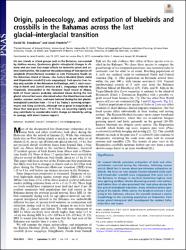Mostrar el registro sencillo del ítem
Origin, paleoecology, and extirpation of bluebirds and crossbills in the Bahamas across the last glacial–interglacial transition
| Autor | Steadman, David W. | |
| Autor | Franklin, Janet | |
| Fecha de admisión | 2024-08-28T22:58:35Z | |
| Fecha disponible | 2024-08-28T22:58:35Z | |
| Año | 2017 | |
| Citación | Steadman, D. W., & Franklin, J. (2017). Origin, paleoecology, and extirpation of bluebirds and crossbills in the Bahamas across the last glacial–interglacial transition. Proceedings of the National Academy of Sciences, 114(37), 9924-9929. Recuperado de: | es |
| URI | https://bvearmb.do/handle/123456789/5076 | |
| Sinopsis | On tropical islands, extensive extirpation of birds and other vertebrates occurred during the Holocene, following human arrival. Much less is known about pre-Holocene extirpation on islands. We focus on two species (Eastern bluebird Sialia sialis and Hispaniolan crossbill Loxia megaplaga) that were lost in the Bahamas to changes in sea level (becoming higher), land area (getting smaller), climate (becoming warmer and wetter), and habitat (loss of pine grassland) that took place during the last glacial–interglacial transition, many millennia before peopling of the islands. While volant, the bluebird evolved a short wing in the Bahamas, whereas the crossbill retained a similar morphology to the surviving population on Hispaniola. Each major glacial–interglacial shift reconfigured the resident Bahamian flora and fauna. | es |
| Idioma | Spanish | es |
| Publicado | Proceedings of the National Academy of Sciences, 114(37), 9924-9929 | es |
| Derechos | Available at: https://www.pnas.org/ | es |
| Materia | Paleobiología | es |
| Materia | Biodiversidad | es |
| Materia | Hábitats y especies | es |
| Materia | Especies amenazadas o en peligro de extinción | es |
| Materia | Avifauna | es |
| Título | Origin, paleoecology, and extirpation of bluebirds and crossbills in the Bahamas across the last glacial–interglacial transition | es |
| dc.identifier.doi | https://doi.org/10.1073%2Fpnas.1707660114 | |
| Tipo de material | Article | es |
| Tipo de contenido | Scientific research | es |
| Acceso | Open | es |
| Audiencia | Technicians, professionals and scientists | es |
Ficheros en el ítem
Este ítem aparece en la(s) siguiente(s) colección(es)
-
Investigación ambiental [1725]


